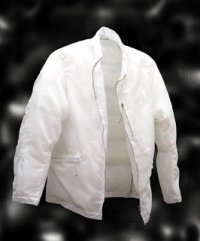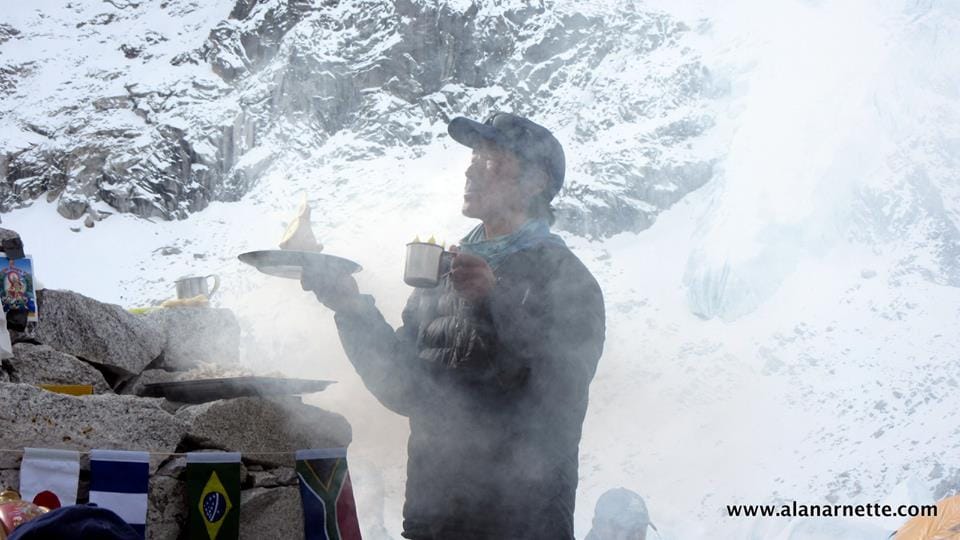
Update: 8/23/2010
Hanesbrands did use their aerogel based SuperSuit on Everest in the spring of 2010. Now three months later they have released the results to the public. It is mixed as I read it. On the positives, case climber Jamie Clark did use their product and did not suffer any ill effects which was no surprise. Of note he wore a traditionally ‘puffy’ down suit on his summit push.
Jamie only wore the external Supersuit to camp 3 which is still in the limited protection of the Western Cwm and not subject to the harshest summit winds. I was under the impression it would be used on their summit push according to all the pre-climb publicity replacing the traditional ‘puffy’ down suit.
As for their published performance results, the bottom line is the suit, while warm, did not breath well in an active environment. The Supersuit was the only clothing that used aerogel however, the other layers designed for the expedition reportedly worked well. Again no surprise since that is Hanesbrand’s core competency, especially the underwear/baselayer.
I was recently contacted by another company using Aerogel, Shiver Shield. Their focus is on outdoor clothing but primarily for sedentary sports such as hunting or ice fishing. Perhaps the material will work in that role.
So it looks like geese still need to be worried since their natural feathers have not been replaced by any man made materials. You can download the Hanesbrand report at this link.
Original Post: 1/31/2010
Manufacturers of all types are always looking for that next great breakthrough. Think: Gortex, Teflon and that famous exchange from The Graduate:
Mr. McGuire: I want to say one word to you. Just one word.
Benjamin: Yes, sir.
Mr. McGuire: Are you listening?
Benjamin: Yes, I am.
Mr. McGuire: Plastics.
Now another breakthrough is hitting the consumer outdoor products market based on a man-made material called aerogel. It is lighter than air in its pure form, warmer than down, can be compressed, is breathable and is virtually unbreakable. It keeps hots things hot and cold things cold – How does it do it?
There seems to be no simple or short answer to what is an aerogel. Most text describe a manufacturing process where liquids are replaced with air involving a polymerization process. Being simple, I like to think of aerogel as a tiny, as in microscopic, layer of bubble wrap; which I am sure makes scientists and engineers cringe.
First mentioned in a paper published in the journal, Nature, in 1931, scientist recognized an opportunity to improve insulation material. Monsanto initially used it in napalm and cigarettes in the 1940’s but it was primarily used as a flattening agent in paint and varnishes.
Monsanto abandoned its use in the 1970’s. It was expensive and difficult to manufacture according to the website areogel.org . One challenge was that exposure to a significant amount of aerogel dust created serious respiratory issues.
Aerogel can be manufactured from many base materials including silca, carbon, copper, gelatin and more exotic combination’s. The secret is a final product that is 98% air – an excellent insulator. We know that air pockets in feathers trap warmth thus providing insulation, however feathers need loft or thickness to function well. Also, feathers are bulky (or puffy in a jacket) and require a serious commitment from the donor.

Enter NASA. Think spacesuit. They needed superior insulation for astronauts and space probes. Oh cost was a minor issue. In 1993, Aspen Systems, of Marlborough, Massachusetts, secured a contract from NASA to develop an aerogel manufacturing process.
Soon, Cryogel®, was used in launch vehicles, Space Shuttle upgrades, interplanetary propulsion, and life support equipment. Now called Spaceloft™, gloves designed for the Mars mission will use aerogels.
Aspen Aerogels, a spinoff company, was tasked with commercializing aerogels and soon got a handle on the difficult manufacturing problems and expanded the product line into window and skylight insulation, non-flammable building insulation, and inexpensive firewall insulation that will withstand fires in homes and buildings. And outdoor clothing. It was successfully tested on an Antarctic expedition.
The performance of the material is astounding providing protection from – 200°C to + 635°C. A 3 mm thick layer of aerogel can protect the human body even at temperatures below -50°C.
A few outdoor products already use aerogels. Burton sold a jacket and mittens with aerogel since 2005. But it costs twice as much as their non-aerogel versions and has been discontinued.
The Gearcaster recently noted a few current offerings:
- The Quiver AeroPoint.50, a water bottle insulator that claims to keep your liquid cold ten times longer than uncovered.
- Camelbak’s Podium water bottle, targeted to cyclists, uses aerogel as the primary insulating agent. They claim 4x increase in staying power at a cost of $20 for a 21 oz bottle.
- Pacific Outdoors has marketed a sleeping pad based on Aerogel since 2007 with good reviews.
- Other products include Toasty Feet insoles and even tennis rackets from Dunlop.
Fast forward to the January 2010 Outdoor Retailer show in Salt Lake City where Hanesbrands with their Champion apparel brand showed more of their climber’s line including their new Supersuit. It uses a version of aerogel they call Zero-Loft Aerogel.
The aerogel layer is the primary insulating material and is sandwiched within three other layers that provide wicking, reflection of body heat and wind resistance. They say it is four times as warm as down.

It will undergo a test on an Everest expedition this spring with Canadian climber Jamie Clark. I already noted their effort last Fall to test the new line on Nepal’s Pumori. While called a suit, it is actually a separate jacket and pant combination.
Precise details on whether products for climbers will be available and price points is still unclear to me.
Mike Abbott, director of research and development for Hanesbrands has been quoted as saying “By developing the Supersuit and other garment layers to be used on Everest, we have identified new Champion products to roll out and new features and enhancements to potentially add to our everyday line of Champion Athletic Apparel.”
One hint of future products comes from this statement in a press release:
The Champion and Duofold brands will use the Everest project’s research discoveries for new products and enhanced products for years to come. The first products inspired by or influenced by the Everest project will come to market in fall 2010.
Champion will introduce Cold Weather Gear that can be layered in various combinations to promote warmth and comfort, a technique that will be used during the Mount Everest expedition. The Champion Cold Weather gear is value-priced training activewear made from lightweight fabrics to maximize mobility and reduce bulk, even while layering for warmth in modest temperatures.
The material has seen Everest before. Climber Anne Parmenter wore a pair of aerogel socks and insoles on her 2006 summit. Her only complaint – her feet got too hot!
We have seen breakthrough claims before with quarks, superconducting materials and plastic. Some made it, others didn’t; primarily due to manufacturing issues and the final cost to consumers. Today, we would add environmental issues to the challenge list for any product.
Climbers in particular seems to try these out and return to natural products like goose feathers and Merino sheep wool. I am totally confident that the Champion gear will protect mountaineer Jamie Clark. The next question is for the rest of us. Can outdoor clothing manufacturers deliver a high quality product, in quantity, at a consumer price point using aerogel?
I hope so because I want one! And maybe geese will stop flying into our planes.
Climb On!
Alan




One thought on “Aerogel – Should Geese Start Celebrating? Updated”
I am interested in ing Pants, Jacket & socks and possibly gloves all made using the layered Aerogel substance.
Are there outlets in SO. Cal.I live in Bakersfield Ca.
TKS
J. Elliott
Comments are closed.